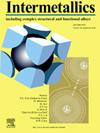Corrosion resistance and mechanical properties stability in simulated seawater of the Vit1 amorphous alloy prepared by controlled cooling rates
IF 4.3
2区 材料科学
Q2 CHEMISTRY, PHYSICAL
引用次数: 0
Abstract
In this study, Vit1 (Zr41.2Ti13.8Cu12.5Ni10Be22.5) amorphous alloy has been prepared using copper, graphite, and steel molds, each with different thermal conductivity, to vary the cooling rates. The fabricated alloy samples were then immersed in a 0.6 mol/L NaCl solution for 100 days to investigate their corrosion resistance and mechanical stability. The experimental results reveal that all the Vit1 amorphous specimens prepared under three different molds exhibited excellent corrosion resistance in the simulated seawater. After 100 days of immersion, the weight losses of the Vit1 amorphous specimens prepared using copper, graphite, and steel molds were 19.47, 29.32, 29.48 mg/cm2, respectively, corresponding to the corrosion rates of 0.1159, 0.1754, and 0.1755 mm/year. Additionally, the tensile strength of all the specimens remained almost unchanged (with a variation of less than 3.5 %), indicating outstanding stability of mechanical properties. Compared to a titanium alloy used as a control sample, the Vit1 alloy showed superior resistance to corrosion-degradation of mechanical properties. Further analysis manifested that the mechanical properties of the Vit1 amorphous alloy after immersion were mainly influenced by its internal microstructure.
求助全文
约1分钟内获得全文
求助全文
来源期刊

Intermetallics
工程技术-材料科学:综合
CiteScore
7.80
自引率
9.10%
发文量
291
审稿时长
37 days
期刊介绍:
This journal is a platform for publishing innovative research and overviews for advancing our understanding of the structure, property, and functionality of complex metallic alloys, including intermetallics, metallic glasses, and high entropy alloys.
The journal reports the science and engineering of metallic materials in the following aspects:
Theories and experiments which address the relationship between property and structure in all length scales.
Physical modeling and numerical simulations which provide a comprehensive understanding of experimental observations.
Stimulated methodologies to characterize the structure and chemistry of materials that correlate the properties.
Technological applications resulting from the understanding of property-structure relationship in materials.
Novel and cutting-edge results warranting rapid communication.
The journal also publishes special issues on selected topics and overviews by invitation only.
 求助内容:
求助内容: 应助结果提醒方式:
应助结果提醒方式:


